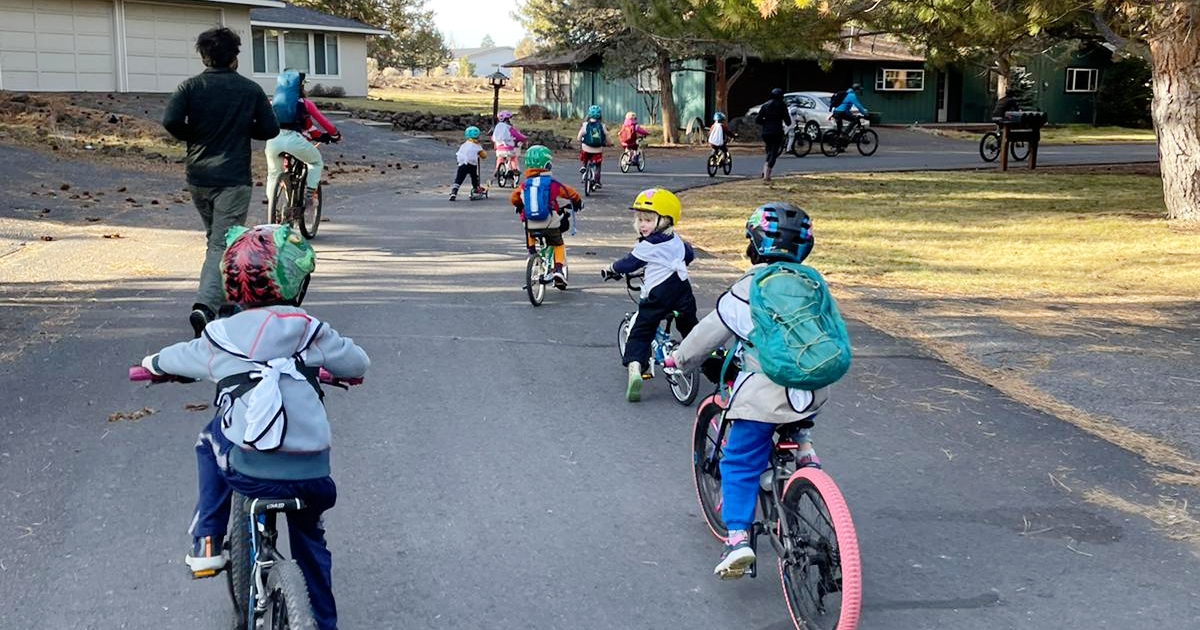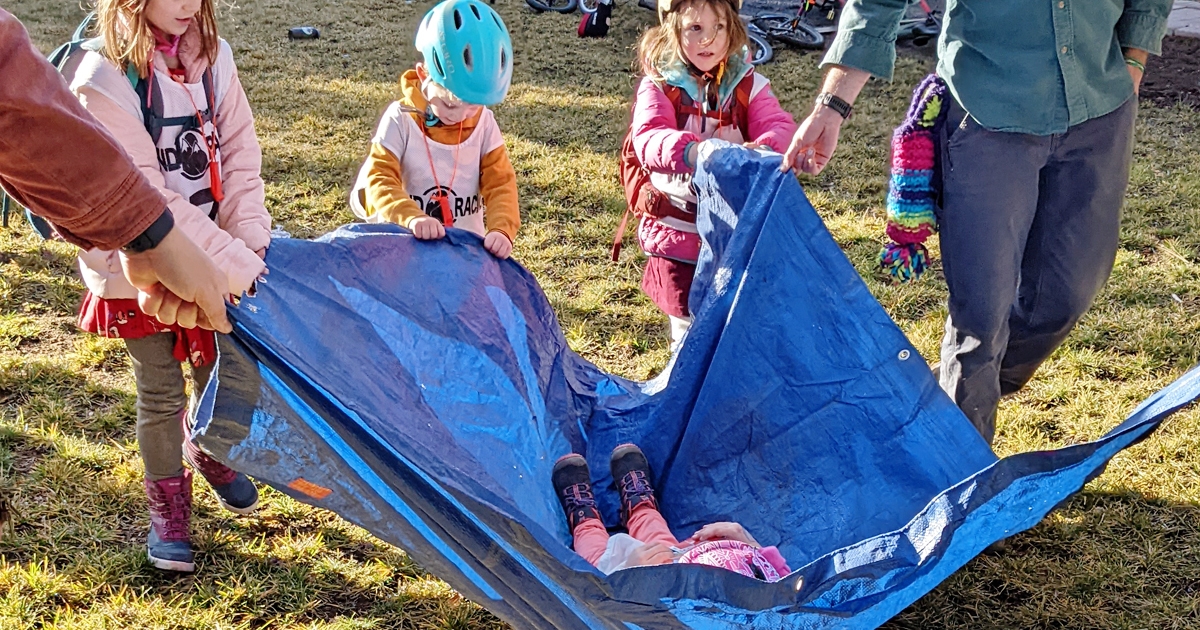How to Throw a Kids Adventure Race Birthday Party
- By Chelsey Magness
- Feb 10, 2022
- 0 Comments

The excitement was palpable as the teams huddled up to make final preparations before the start. They had just been given their maps and race passports minutes before. In many ways it felt like all the other adventure races we put on, except this time the athletes were much younger, shorter and had a little less of an attention span. Jason counted down “5, 4, 3, 2, 1, GOOOO” and they were off. Four teams of 4-5 year olds raced off on bikes while their parents ran behind them.
As race directors and professional adventure racers, putting on a kids adventure race for our son's 5th birthday was on brand. If you're not familiar with adventure racing, it's a multidisciplinary team sport involving navigation over an unmarked wilderness course with races extending anywhere from two hours up to two weeks in length. Teams navigate via map and compass, and race directors place checkpoints that they have to punch to show they were at the right spot. To adapt it for kids, we made the course much shorter, and focused on the rewarding parts of adventure racing such as teamwork, punching the check points, having a map, overcoming obstacles, and using all your gear!
These days, the classic birthday party is to either drop your kids off, or stand on the side lines while your kid plays in the bouncy house or jungle gyms until they are spent and ready for cake. While we see the appeal, we’d rather be playing with our kids outside. So when our son asked us to put on a birthday adventure race for all of his friends, we were overjoyed.
If you are anything like us, and want to throw a birthday party for your kids that you and the parents will enjoy as well, we put together some tips on how to do it in case you want to give it a go!
1. Work with what you have, and don’t make it too stressful or complicated.

Rather than going out to a far away park or wooded area that you are unfamiliar with, put it on at a place that you know like the back of your hand. We put ours on right in our own neighborhood. We get a ton of neighbors involved and use their backyards and our nearby forests to make an amazing, fun-filled course.
2. Emphasize the team aspect and downplay the competition.
While the word “race” is in the title, we try to downplay the competitive nature of it and put more attention on the fact that it is about being a team and working together. Before and after we group kids together (we do this by skill and age) we always say that we are all one big team. One of our rules is that we always help each other out, no matter if they are on our team or not. We have found that making this a focus from the beginning brings down any tension and invites in an overall feeling of teamwork, fun and community.
3. Have something tangible at each checkpoint.

Make sure to have an easy to eat snack and or something useful at each checkpoint. We put a challenge at a few checkpoints that accompanied an item they got which proved to be both fun and an opportunity to give a lesson. For example, at one of the first checkpoints we gave out whistles that had a small Nite Ize S-Biner on the end of it. For the rest of the race they had to blow it and get to the side of the road whenever they saw a car coming, then when the rest of the teams heard a whistle, they knew to get off the road and wait till the car had passed. For the other checkpoints, we gave out Nite Ize NiteGems, treats that were in plastic eggs (this lets us buy snacks in bulk and cut down on wrappers), and other useful items like a mini compass, a sun hat and a mini insulated cup that was filled with hot cocoa and mulled wine for the adults!
4. Have some adult party favors too.
Since parents are the main support crew, we love to take care of them. At some of the checkpoints we make sure to have beers and some of our favorite and useful items like Gear Ties. This makes them feel appreciated and excited to be in it with their kids.
5. Don’t shy away from letting the kids work things out.

It is very hard to watch your kids make mistakes, especially in a race setting where the clock is ticking. However, going the wrong way (for a little bit), having a hard time with a challenge or with in their team is all part of the learning process. Of course we don’t want parents to let their kids go too far out of the way, but letting them figure out as much as possible on their own will raise their confidence level and empower them more than ever.
At one checkpoint, we gave out a bunch of mini first aid kits from Adventure Medical Kits. Each team had to pick an injured teammate, that kid then had to get dragged on a tarp to a certain point by the rest of their teammates. Once at the point, the other teammates had to put a bandaid on their “cut” before heading on to the next CP!
6. Don’t make it too easy. Work within your risk assessment, but don’t be scared to play at the edge.
A big part of adventure racing is getting dirty, overcoming fears and doing things that you never thought you could do. As parents, it is way too easy to keep your kids from doing things that scare you. However, when we step outside of our comfort zones and let them do things that are at their edge (or more accurately, your edge), they learn just how capable they are. And if they fall, they will learn even more for the next time! Our son REALLY wanted to climb the rock wall with his biking gloves on, I warned him that it would be harder, but he was adamant on trying. He fell off of a hold, and scraped his knee a bit. He came back, cried for a minute, but then after hearing his team cheer him on, he tried again and made it. It was hard for me to watch him try again, but he did it and was so excited about getting to the top!
7. Don’t make it too short.

When we are thinking about kids, we tend to go overboard on shortening the course. Don’t be afraid to keep it long, we want them to be tired and so happy to finally be at the finish line, feeling accomplished and like they left everything out there. If we make it too short (which we have done in the past) you are left with kids wanting more and not as inspired as if they had gone through the whole experience of pushing through their own and team challenges. And remember, each kid has a parent to help, so if need be, they could always help push or encourage their kids to keep going.
To give you an idea, we made a course in our neighborhood that was about 2 miles long and had 10 checkpoints for 4-5 year olds. Half of the checkpoints had challenges where they had to navigate their way down under a bridge, climb up a wall and even start a little fire (in a very safe fire proof area). This took about 2 hours and was the perfect length.
8. Try to make it feel like a real race as much as you can.

When we put on or compete in adventure races, we use maps, passports, and compasses. So for our kids races, we do the same. At the start of the race, we give them a map with all of the checkpoints on it, a clue sheet (that the parents or an older child reads aloud) and a passport (a little piece of paper with all the checkpoints on it and a place to punch). And because we already own race jerseys, we give each kid a jersey to wear. If you do not have access to jerseys, having kids come in their team color is just as good. Little things like this makes it feel legit and important.

Lastly, HAVE FUN, and enjoy the outdoors with the little ones. And after talking with the parents during and afterwards, they were amazed and so grateful for all the time and energy we put into it. Apparently this was like no other party they had ever been to. If you give this idea a try, it's a birthday party your guests – both young and old – won't soon forget.









